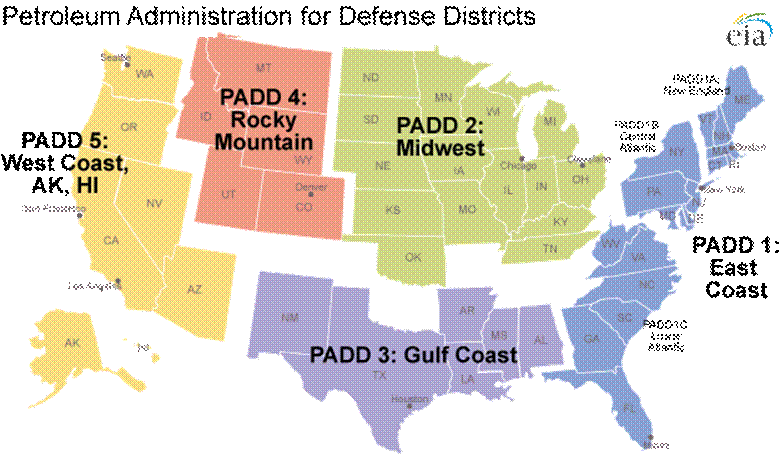 |
 |
 |
 |
 |
 |
 |
 |
 |
 |
      |

January 2017 SEE Monthly UpdateNew Era for MidContinent Refiners
For this review, the MidContinent is defined to comprise Petroleum Administration Defense Districts (PADDs) II and IV as shown above. Among these twenty states, only South Dakota, Nebraska, Idaho, Iowa, and Missouri do not have at least one working refinery. By contrast, the large majority of states in PADD I (the East Coast) do not have refineries. PADDs II and IV together have 4.8 million barrels per day (BPD) of crude oil capacity operated by about thirty different companies in 44 refineries. The newest of these is a 20,000 BPD facility in North Dakota. Thus the MidContinent has about a quarter of the United States’ refining capacity. This is similar in size to the West Coast. Most of the remainder, the other half, is on the Gulf Coast. Although landlocked, oil supply to the MidContinent refineries comes from indigenous production--Oklahoma’s SCOOP and STACK, North Dakota’s Bakken, Wyoming and Colorado’s Julesberg Basin, with smaller amounts from other states. Oil can also be supplied from Canada (more below). (The latest news on Oklahoma earthquakes: the state of Oklahoma has developed seismicity guidelines: should and earthquake of magnitude 3.0 or more occur in the vicinity of fracking operations, the operations will be slowed or stopped. ) Additionally, the MidContinent has pipeline access to any crudes worldwide that can be stored at Cushing or that land at the US Gulf Coast. With a higher likelihood the Keystone XL pipeline will soon be approved, Canadian crude supplies to the MidContinent could increase. Approval of the Dakota Access Pipeline (DAP) is also more likely; however, the result for DAP will be not increased supply but safer transport: pipelines account for far fewer accidents per crude-mile than do the substitute modes of rail or trucking. Because crude oil can now be exported, US oil producers are not captive suppliers to these refineries. Proximity nonetheless increases availability and reduces cost. Moreover, crude oil—the major cost for refiners—is priced globally and despite OPEC and Russian promises to reduce global oversupply, most producing companies and countries have strong incentives to increase production. The subscriber section compares public companies with significant percentages of the MidContinent’s oil refining capacity. For more information, log in now or, if you are not already a subscriber, subscribe now.
Copyright 2017, Starks Energy Economics, LLC. This information may not be disclosed, copied or disseminated, in whole or in part, without the prior written permission of Starks Energy Economics, LLC. This communication is based on information which Starks Energy Economics, LLC believes is reliable. However, Starks Energy Economics, LLC does not represent or warrant its accuracy. This communication should not be considered as an offer or solicitation to buy or sell any securities.
|

All content © Copyright 2024 | Starks Energy Economics, LLC.

